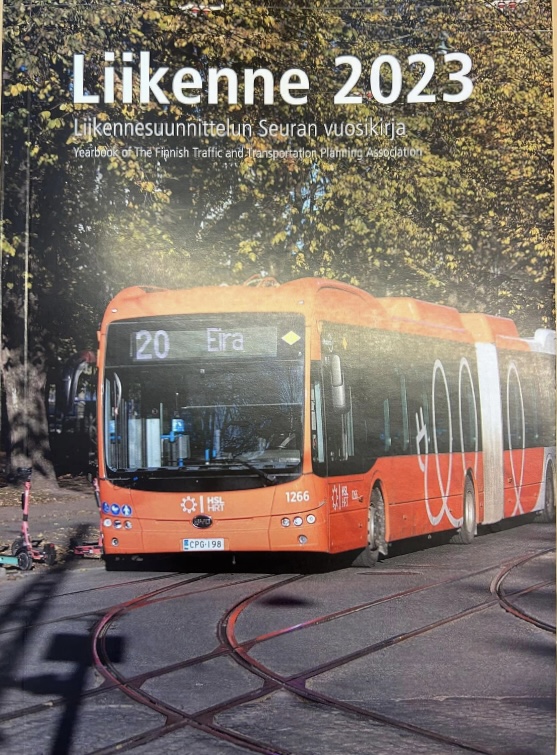Efficient bicycle networks and expansion strategies
DOI:
https://doi.org/10.58956/liikenne.142998Avainsanat:
.Abstrakti
This article explains some of the key attributes and factors relating to efficient bicycle networks and their expansion strategies. Varying from a network scale to brief discussion about the streetscape design, many scientific publications are referenced to explain the crucial aspects which must be taken into consideration when planning an attractive cycling network. Modal switch from other transport modes, especially from cars is one of the goals of this cycling promotion. Various methods such as building new bicycle facilities, improving the quality of existing ones and increasing the comfort and safety of the connections were found to improve the attractiveness of cycling in urban context. Additionally, this article analyses the reasons behind cyclists’ route choice as well as the metrics such as connectedness, directedness and coverage which can be used to measure the level of network functionality. Lastly, network growth under limited resources is considered and an equitable distribution of cycleways across the city is found to be important in preventing neighbourhood segregation while not being too far from a utilitarian kind of distribution in terms of return to investment.
Lähdeviitteet
Boisjoly, G., Lachapelle, U. and El-Geneidy, A., 2020. Bicycle network performance: Assessing the directness of bicycle facilities through connectivity measures, a Montreal, Canada case study. International journal of sustainable transportation, 14(8), pp.620-634. https://doi.org/10.1080/15568318.2019.1595791
Broach, J., Dill, J. and Gliebe, J., 2012. Where do cyclists ride? A route choice model developed with revealed preference GPS data. Transportation Research Part A: Policy and Practice, 46(10), pp.1730-1740. https://doi.org/10.1016/j.tra.2012.07.005
Buehler, R. and Dill, J., 2016. Bikeway networks: A review of effects on cycling. Transport reviews, 36(1), pp.9-27. https://doi.org/10.1080/01441647.2015.1069908
Carl, K., Brown, S.A., Dror, M. and Durcikova, A., 2013. Bicycle tours: modeling the perceived exertion of a daily path. Journal of Quantitative Analysis in Sports, 9(2), pp.203-216. https://doi.org/10.1515/jqas-2012- 0052
Crane, M., Rissel, C., Standen, C., Ellison, A., Ellison, R., Wen, L.M. and Greaves, S., 2017. Longitudinal evaluation of travel and health outcomes in relation to new bicycle infrastructure, Sydney, Australia. Journal of Transport & Health, 6, pp.386-395. https://doi.org/10.1016/j.jth.2017.07.002
Dill, J., 2009. Bicycling for transportation and health: the role of infrastructure. Journal of public health policy, 30, pp.S95-S110. https://doi.org/10.1057/jphp.2008.56
Dill, J. and Carr, T., 2003. Bicycle commuting and facilities in major US cities: if you build them, commuters will use them. Transportation research record, 1828(1), pp.116-123. https://doi.org/10.3141/1828-14
Mahfouz, H., Arcaute, E. and Lovelace, R., 2021. A road segment prioritization approach for cycling infrastructure. arXiv preprint arXiv:2105.03712. https://arxiv.org/abs/2105.03712
Maslow, A.H., 1943. A theory of human motivation. Psychological review, 50(4), p.370. https://doi.org/10.1037/h0054346
Nello-Deakin, S., 2020. Environmental determinants of cycling: Not seeing the forest for the trees?. Journal of transport geography, 85, p.102704. https://doi.org/10.1016/j.jtrangeo.2020.102704
Reggiani, G., Salomons, A.M., Sterk, M., Yuan, Y., O’Hern, S., Daamen, W. and Hoogendoorn, S., 2022. Bicycle network needs, solutions, and data collection systems: A theoretical framework and case studies. Case studies on transport policy, 10(2), pp.927-939. https://doi.org/10.1016/j.cstp.2022.03.006
Stinson, M.A. and Bhat, C.R., 2003. Commuter bicyclist route choice: Analysis using a stated preference survey. Transportation research record, 1828(1), pp.107-115. https://doi.org/10.3141/1828-13
Szell, M., Mimar, S., Perlman, T., Ghoshal, G. and Sinatra, R., 2022. Growing urban bicycle networks. Scientific reports, 12(1), p.6765. https://doi.org/10.1038/s41598-022-10783-y
Vybornova, A., Cunha, T., Gühnemann, A. and Szell, M., 2022. Automated detection of missing links in bicycle networks. Geographical Analysis. https://doi.org/10.1111/gean.12324
Winters, M., Teschke, K., Grant, M., Setton, E.M. and Brauer, M., 2010. How far out of the way will we travel? Built environment influences on route selection for bicycle and car travel. Transportation Research Record, 2190(1), pp.1-10. https://doi.org/10.3141/2190-01
Tiedostolataukset
Julkaistu
Numero
Osasto
Lisenssi
Copyright (c) 2024 Joel Talvitie, Veeti Kuivalainen

Tämä työ on lisensoitu Creative Commons Nimeä-EiKaupallinen-EiMuutoksia 4.0 Kansainvälinen Julkinen -lisenssillä.



